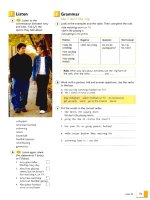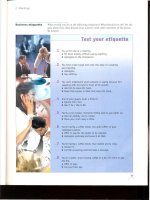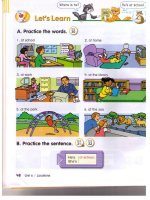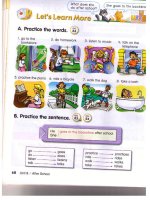Times zones level 2 second students book
Bạn đang xem bản rút gọn của tài liệu. Xem và tải ngay bản đầy đủ của tài liệu tại đây (21.2 MB, 148 trang )
+ CENGAGE
là
Catherine Frazier
Richard Frazier
Jennifer Wilkin
~
SECOND EDITION
NATIONAL
GEOGRAPHIC
rca ING
-
17Ns CENGAGE
Learning
Catherine Frazier
Richard Frazier
Jennifer Wilkin
SECOND EDITION
NATIONAL
GEOGRAPHIC
LEARNING
il + Japan + K
|
CENGAGE
Learning
Singapore « Spain + Uni
NATIONAL
LEARNING
` CENGAGE
+* Learning'
GEOGRAPHIC | ¿_
Time Zones Student Book 2
Second Edition
Catherine Frazier, Richard Frazier,
and Jennifer Wilkin
Publisher: Andrew Robinson
Executive Editor: Sean Bermingham
Senior Development Edit. : Derek Mackrell
Development Editors: Sian Mavor,
Charlotte Sharman
Assistant Editor: Melissa Pang
Director of Global Marketing: lan Martin
Product Marketing Manager: Anders Bylund
Media Researcher: Leila Hishmeh
Senior Director of Production:
Michael Burggren
Senior Content Project Manager:
Tan Jin Hock
Manufacturing Planner:
Mary Beth Hennebury
Compositor: Cenveo Publisher Services
Cover/Text Design: Creative Director:
Christopher Roy, Art Director: Scott Baker,
Senior Designer: Michael Rosenquest
Cover Photo: John Coletti/JAI/Corbis
Copyright © 2016 National Geographic Learning, a part of Cengage Learning
ALL RIGHTS RESERVED. No part of this work covered by the copyright herein
may be reproduced, transmitted, stored or used in any form or by any means
graphic, electronic, or mechanical, including but not limited to photocopying,
recording, scanning, digitizing, taping, Web distribution, information networks,
or information storage and retrieval systems, except as permitted under
Section 107 or 108 of the 1976 United States Copyright Act, without the prior
written permission of the publisher.
For permission to use material from this text or product,
submit all requests online at cengage.com/permissions
Further permissions questions can be emailed to
Student Book with Online Workbook:
ISBN-13: 978-1-305-51072-2
Student Book:
ISBN-13: 978-1-305-25985-0
National Geographic Learning
20 Channel Center Street
Boston, MA 02210
USA
Cengage Learning is a leading provider of customized learning solutions with
employees residing in nearly 40 different countries and sales in more than 125
countries around the world. Find your local representative at:
www.cengage.com
Cengage Learning products are represented in Canada by Nelson Education, Ltd.
Visit National Geographic Learning online at NGL.Cengage.com
Visit our corporate website at www.cengage.com
Printed in the United States of America
Print Number: 01
Print Year: 2015
Scope and Sequence.
4
What Do You Like to Do?
6
What's for Dinner?
68
What Does She Look Like?
16
You Should See a Doctor!
78
| Bought New Shoes!
26
| Often Skate After School.
88
What's the Coldest Place
on Earth?
Are Cats Better Pets
Than Dogs?
36
46
| Really Like Electronic Music!...56
How Do You Get to
the Mall?
What Were You
Doing?
We're Going to Volunteer!
98
108
118
66
128
Student
B Activities............... 130
Table of Iregular Verbs............. 135
Photo and Art Credits............. 142
Acknowledgments .
.. 143
LanguageNBfes.................
136
SCOPE AND SEQUENCE
1
What Do You
Like to Do?
Page 16
Functions
Grammar
Talking about
one's favorite
hobbies
Asking about activities:
What do you like to do?
Do you like to play tennis?
Expressing time and
frequency:
How often do you exercise?
When do you have class?
Talking about
how often one
does an activity
Real English:
I'm good.
Describing
physical
appearance
Real English:
I'm on my way.
What Does She
Look Like?
Page 26
Identifying
different types
of clothing
Talking about
shopping
| Bought New
Shoes!
4
Page 36
What's the Coldest
Place on Earth?
Page 46
>
Real English:
What's wrong?
Describing
places around
the world
Real English:
Donftworry
about it.
Making
comparisons
Real English:
Actually
Hobbies
Reading:
Incredible Kids
Interests
Reduction: to
Favorite
activities
Writing:
Video:
Bird Girl
Adverbs of frequency:
once, twice, three times a week
Asking about and describing
physical appearance:
What do you look like?
Physical
appearance
She has long hair.
Consonant
blends:
b/, br,
gl, gr
Adjectives:
short/long/straight/curly hair
green/brown eyes
medium height
Time expressions:
recently
last weekend
Clothes
Accessories
Consonant
blends with s
two days ago
the world?
longest
biggest
Extreme
places on
Earth
Sentence
stress
Poster
Video:
Earth’s Coldest Place
Comparatives:
Which are more playful, rabbits
Reduction:
than
or turtles?
bigger
friendlier
Video:
worse
more playful than
Expressing likes
and dislikes
best?
Which do you like better?
Hove it
Real English:
Not exactly.
I can't stand it.
| like rap better.
Reading:
Dogs with Jobs
Writing:
Blog post
cuter
What kind of music do you like
Extreme Amazon!
Writing:
most beautiful
best
Asking for and expressing
opinions:
Do you like rock?
Yarn Bomb!
Video:
Walking in Style
tiniest
Identifying
music genres
and musical
Reading:
Writing:
Article
just
What's the tallest mountain in
Writing:
Video:
Great Facial Hair
last year
Superlatives:
Reading:
First Impressions
Description
He has brown eyes.
better
instruments
| Really Like
Electronic Music!
Read, Write, & Watch
worst
Are Cats Better
Pets Than Dogs?
Page 56.
Vocabulary | Pronunciation
Strange Cats
Music
genres
Musical
instruments
Syllable
stress
Reading:
The Feel of Music
Writing:
Music review
Video:
The Steel Band
in
Functions
7
What’s for Dinner?
Identifying
things in the
kitchen
Expressing
quantity
problems
Asking for and
giving advice
Talking about
daily routines
Real English:
Just a minute.
| Often Skate
After School.
10
How Do You Get
to the Mall?
Page 108
11
What Were You
Identifying
12
We're Going to
Volunteer!
Quantifiers:
Food
Reading:
ASlice of History
some
any
Utensils
Things in
Linked
sounds
Writing:
Text message
the kitchen
Video:
The King of Fruits
Asking for and giving advice:
What should| do?
You should take some medicine.
You shouldn't go to school.
Why don't you see a doctor?
Health
Injuries
Parts of the
Should, could,
would
body
Comparing present
progressive and present
simple:
1am studying in school.
Jalways study in school.
Asking for and giving
Go straight down this street.
Real English:
No problem.
How do you get to the park?
Daily
Homophones
routines
Habits
Video:
Skateistan
Places in
the city
Directions
Reading:
Cities on the Move
Writing:
Walking tour
Video:
City Walker
between, behind, across from, in
front of, next to, on the corner of
Comparing the past
Talking about
risks
Real English:
Hurry up!
simple:
Were you eating when she
progressive and the past
Risk
Adventure
Diving with Sharks
Writing:
Personal narrative
Video:
Dangerous Waters
called?
What were you doing last night?
Iwas going down the stairs
when I fell.
Talking about
future plans
Talking about
volunteering
and charity
events
Real English:
Definitely!
Reading:
An Unusual
Commute
Description
Turn left/right.
Prepositions of place:
Describing past
experiences
Medicine
Writing:
Article
Adverbs of frequency:
once in a while, seldom, rarely,
hardly ever
giving
directions
Laughter is the Best
Laughter Yoga
directions:
Where's the museum?
Asking for and
Reading:
Video:
city
places in the
Doing?
Page 118
Read, Write, & Watch
Real English:
Come on!
and activities
Page 98
Vocabulary | Pronunciation
I can't wait!
health-related
Page 88
Grammar
Real English:
Talking about
You Should See a
Doctor!
ì
Future with present simple:
I'm going to volunteer.
What are you going to do?
When is the charity fair?
The charity event is tomorrow.
Charity
events
Voluriteer-
ing
Community
service
Reduction:
going to
Writing:
Proposal
Video:
Coastal Cleanup
Preview
Look at the photo. Complete the caption.
practicing
do sports
hobby
Listen. Complete the sentences.
3%
play tennis
w
doorigami
&
collect comic books _
¢
play the guitar
draw
1. Tracey likes to____
It’s. a kind of paper art.
2. Daniel likes to ____.
He buys them online.
3. Sara likesto_———————.
She does it twice a week.
4. Chris likes to
but he doesn't like sports.
and
Talk with a partner. What hobbies do you have?
What do you like to do?
Grate
Cool. What other things do you like to do?
®
oo
xa
5 er
They are
na
Ponder
for a race.
Language
đà
Focus
REAL ENGLIS
x3 Listen and read. Then repeat the conversation
and replace the words in blue.
I'm goo:
Practice with a partner. Replace any words to make your own conversation.
I like to play soccer.
How about
you, Maya?
What do you
like to do after
Well, | like to play
the guitar. Hey,|
can play for you!
school, Stig?
drums
piano
play volleyball
draw
`
Uh, Maya... what
|
else do you like to do?
What's your
|
Well, | really
like to sing.
favorite song?
I can sing it for
you.
love to sing
enjoy singing
(TALKING
ABOUT
=
HOBBIES
What do you like to do
on weekdays / on weekends?
Do you like to collect things?
I like to play sports.
Yes, | do.
No, | don't.
| play once / twice / three times
How often do you play soccer?
a week.
| never play soccer.
ae
8
Unit1
do you do karate?
| do it before / after school.
_
I'm good, Maya. Um,
(Let's watch a movie!
=)
ED
Listen. Complete the conversation.
Ming:
Nadine, what do you do (1) _______
Nadine:
_Well, I
Ming:
Really? How often do you play volleyball?
Nadine:
| play (3) _______
Ming:
Nadine:
Ming:
Nadine:
©
play
py
volleyball
ybal
school?
and I go to(2)__—_—_—_—_—— class.
and | go to (2)
“Once bitten, twice shy”
means to be ——
about
something after a bad
experience.
times a week, Mondays to
Wednesdays. My guitar classes are on the other days.
| What do you do before school on weekdays?
aangly
b.sad
c. careful
| play soccer once a week, on (4)
What do you like to do on weekends?
| do karate on (5) ______.
On Sundays, | do homework!
Complete Nadine’s schedule. Use the information in C.
7:00-8:00
8:00-3:00
3:00-5:00
volleyball
guitar class guitar class
Work with a partner. Complete the Questions column of the chart on your own. Then
take turns to ask your partner questions. Write his or her answers in the Answers column.
( QUESTIONS
ANSWERS
Ầ
1. What do you like to do after school?
2. Do you like to...
3. How often do you...
Unit1
9
The Real World
Robot
Scientist
He studies
how robots can learn
and work with humans.
Complete the sentences. Use the words in the box.
learn
dangerous
Some(1)___———
differ
carry
messy
tasks
aredifficultor(2)_———
— for people. But robots can help us with them.
There are many (3)__—————
kinds ofrobots. Some help us to clean a (4)__—————— house or
heavy things. Some robots help us (6) _________ more about places outside Earth.
WY
Listen. Check (/) the things that Jenkins’ robot can do.
ay video
es
) read comics
ean ther
CRITICAL THINKING
(_)
dance
Pronunciation
Reduction: to
Listen and repeat.
1. What do you like to do?
2. Does she like to draw?
3. I like to play tennis.
4. | don't like to play sports.
Listen. Complete the sentences.
1. What do you?
2.Doyou_———————
—
thepiano?
3.1 _D—————
karate.
Korean food,
4. My parents
5. Mymother doesnt___DDDDDDD
everyday.
Work with a partner. Take turns to read the sentences in B.
|
Karate is a martial art
from
avchiba
ề
b. Japan
c. Korea
Communication
When do you have math class?
How often do you play soccer?
Unit?
TT
Cécilia Cassini wearing
the clothes she made
'
Reading
The article is about three children’s __.
a. hobbies
b. clothes
c. books
Scan the article. Match the people to their hobbies.
1. Cécilia
. Hawkeye
3. Malachi
a. takes photos
b. plays drums
c.
makes clothes
Scan the article again. When did they start their
hobbies? Underline their ages.
These children are doing amazing things.
Cécilia Cassini likes to wear beautiful clothes. She also likes to make
clothes. She does her homework in school at recess every day. After
school, she likes to sew! Cécilia started to sew at age six. Her designs
are famous. Sometimes she makes dresses for famous people like
Taylor Swift. She also makes clothes for poor children.
Hawkeye Huey likes to take photos. He started his hobby when
he was only four. Hawkeye uses an instant camera to take photos.
He takes many photos of people and places. Hawkeye’s father, Aaron,
created an Instagram account for him and posts his photos there.
The account has more than 60,000 followers! Aaron also takes
Hawkeye to different places to take photos. He says it’s great for
Hawkeye to meet different people and see their way of life.
Malachi Samedy likes to collect comic books and play computer
games. But Malachi loves to play the drums more than anything else.
At age two, he got his first drum set. At age four, he went to music
school. Now he performs all over the world by himself and with
famous musicians. He likes to perform for other children. He also
wants to teach children from around the world to play the drums.
He wants to inspire them to try new things.
Hawkeye Huey
taking photos at
Salvation Mountain
in California, U.S.A.
‘Sm
»
x.
Comprehension
Answer the questions about Incredible Kids.
1. Detail) Cécilia makes clothes for.
a. her pets
b. adults and children
c. children only
2. Reference’ In line 10,”him” refers to___.
a. Hawkeye
b. Aaron
c. aperson Hawkeye met
3. Inference. Aaron thinks photography can help Hawkeye learn about ___.
a. people's hobbies
b. traveling
c. people different from him
4, ‘Detail’ Malachi’s favorite hobby is ___.
a. collecting comic books
b. playing the drums
c. helping other children
5. Vocabulary To “inspire” means to ____ to do something. (line 20)
a. order someone
b. ask for help
c. make someone want
) Work with a partner. Check (/) the correct person. More than one answer is possible.
Who...
Cécilia
Hawkeye
Malachi
» helps other children?
. Started their hobby before they
were five?
. works with famous people?
. takes photographs of people
and places?
Talk with a partner. Which person do you think is the most amazing? Why?
Jal
Writing
Write an email. Tell a
friend about your hobbies
and interests.
From: Amy
To: Sophia
Subject: How are you?
Hi Sophia!
It’s Amy from Australia. | have a new hobby. It’s playing the guitar. |
like to play the guitar a lot. | play after school with my friends. What
are your hobbies? Do you like music? Write back soon!
Amy
14
Unit1
VIDEO
Bird Girl
ABOUT
VIDEO
Mary Lou makes some
new friends after
moving to her new
home.
Talk with a partner. How many different kinds of birds do you know?
WHILE
YOU
WATCH
Check (/) the things that Mary Lou likes to do.
Mary Lou likes to___.
©
watch birds
() keep pet birds
(_) write about birds
©
draw birds
(.) make songs about birds
or F for False.
1. Mary Lou became interested in birds at school.
T
2. Mary Lou usually watches birds at the zoo.
T
3. Mary Lou learns about birds on the Internet.
T
4. Mary Lou still likes to do the same things as other children.
AFTER
Abird
watcher
YOU
T
7
Watch the video again. Circle T for True
mm
7
THE
BEFORE YOU WATCH
WATCH
Talk with a partner. What kind of birds can you see in your country?
Do you think bird watching is an interesting hobby?
Preview
Listen. Circle the words you hear.
1. Person A has (long / short) red hair.
—
/ curly) brown hair.
2. Person B has (wavy
—
3. Person C has (blond / black) hair and (green / blue) eyes.
—
/ brown) eyes.
4, Person D has (black/ brown) hair and (blue
Ss
/ green) eyes.
/ short) black hair and (brown
5. Person E has (spiky
a=
Look at the photos. Find people to match the descriptions in A. Write the
numbers.
Work with a partner. Choose three people in the photos and write notes
about them. Describe the people to your partner.
(PERSON
DESCRIPTION
This person is male.
He has short black hair.
Ease ae
ome
e
short brown hair
blue eyes
Language Focus
(yeu)
Listen and read. Then 8 repeat the conversation
Dr
and replace
the words in blue.
Mcooicicuj7"
"1
onmy way.)i
non my way
Practice with a partner. Replace any words to make your own conversation.
a
Ming, I’m at the
game now. Where are you?
She has short
blond hair and
| —
SS
]
=>
|
J
=
straight black / brown
spiky red
/ green
I'm... Oh! It’s you, Stig!
No, she doesn't.
| think she’s wearing
a red T-shirt.
blue pants
a green shirt
|
( DESCRIBING PEOPLE
What does he look like?
Hi there
bì
He's tall and he has short, curly hair.
I'm short and | have long, straight red hair.
What do you look like?
I'm medium height and | have freckles.
Xà
18
| have braces and | wear glasses.
Unit2
_
Look at the photo above. Complete the sentences.
short
brown
curly
blond
straight face” means
I
.
glasses
1. He's tall and has___
2.Shes__———
—
“| couldn't keep a
medium height
Wavy
a. cried
b. laughed
brown hair.
c. talked
and she has straight hair.
3. Shes_————————
hair.
andshehas curly
Shewears_—_———,t†oo.
4.Hehas_—————
—
brown hair.
5. Shes tallandhas_———— hair.
Ey
Listen. Complete the conversations.
1. Joyce:
Hey, there’s a new boy in class.
Ben: _ Oh,really?What does he(1)_—————————— ?
Joyce:
2. Mike:
Hes(2)__———
—
and he has (3)
hair.
Do you see my sisters?
Tina:
(49_—————————————looklike?
Mike:
They wear (5) _____
and they have (6)
Work with a partner. Student A: Choose a famous person. Describe him or her to
your partner. Student B: Guess the famous person.
This person is an actress and a singer. She’s medium height.
She has long, curly brown hair. She has big brown eyes.
estar Meloy
Unit2
19
The Real World
Mind
Power
She wants to help peopl
learn more about how their bfAIfNS WØOE
Her device, the Emotiv Insight, helps
people to have better, healthier livess
Aman
using the
Emotiv Insight
Work with a partner. Read the information
above. Look at the photos. What do you
think Tan Le’s device does?
EQ Listen. Circle T for True or
F for Fa
sight collects
information on your
heart.
CRITICAL THINKING
. The Emotiv Insight lets you drive
without using your hands.
3. The Emotiv Insight changes your
physical appearance.
4, The Emotiv Insight is useful for
studying our brains.
Pronunciation
blends: bi, br, gl, gr
Consonant
Listen and repeat.
1. blue
2. brown
3. glasses
4. gray
feyeey
Listen. Circle the sounds you hear.
1. gr
br
5. bl
gl
2. gl
6.
gr
bl
3. gl
br
7.
gr
bị
4.br
br
8.
gr
gr
br
9
9
:
9
Work with a partner. Take turns to read the words below.
1. braces
2. grow
3. glad
4. blink
5. bring
6. blow
7. global
8. greet
Which country has the
highest percentage of
people with red hair?
a. France
c.E:PMENE
Scotland
Play a guessing game. Look at the photo on page 130. Student A: Choose one
person in the photo. Don’t tell your partner who it is. Student B: Ask yes/no
questions to guess who your partner chose. Take turns.
Does the person have black hair?
Does the person wear glasses?
TT
ea
"lige
i
“
Photographer Cory
Richards meets some_ <
children in Peru
Reading
Look at the photo. What do you think these people are like?
Skim the article. When do people create a first impression?
a. when they meet someone new
b. when they know someone well
Scan the article. When is a good first impression important?
We look at people's physical appearance, such as eyes, hair, and
height, all the time. When we meet someone we don't know, we
create an idea of what that person is like in our mind. This is called a
first impression.
How do we create first impressions of people? Most of the time, we
see what the person looks like. For example, we may think that a
person wearing glasses looks smart.
A writer, Malcolm Gladwell, wrote about how we make decisions
using our first impressions. He did a survey of the leaders of big
companies in the United States. He found that a lot of them were tall
men—about 1.8 meters. Most men in the United States are about
1.75 meters tall. Gladwell says that we choose taller people to be our
leaders without knowing it. This is because tall people feel like
leaders to us. But not everyone agrees. We don’t always make
important decisions based on only our first impressions.
Giving people a good first impression can be important, like in a job
interview. But first impressions are not always true. We often change
how we feel about people when we know them better.
Unit2
23









